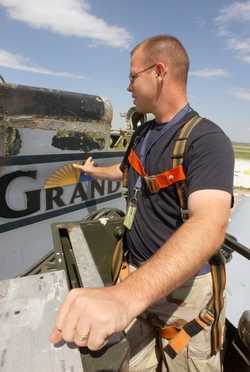 Twenty minutes before landing,
all systems were normal, the mission had gone flawlessly and the
crew of "Shell 02" was ready to complete another successful
refueling flight supporting Operation Enduring Freedom. But 10
minutes and two lightning strikes later, the only thing resembling
"normal" aboard the aircraft was the poise of a well-coordinated
aircrew.
Twenty minutes before landing,
all systems were normal, the mission had gone flawlessly and the
crew of "Shell 02" was ready to complete another successful
refueling flight supporting Operation Enduring Freedom. But 10
minutes and two lightning strikes later, the only thing resembling
"normal" aboard the aircraft was the poise of a well-coordinated
aircrew.
The KC-135 Stratotanker crew, from the 22nd Expeditionary Air
Refueling Squadron, was returning to Ganci Air Base, Kyrgyzstan, on
Monday after refueling Danish F-16s that were providing close-air
support to coalition forces in Afghanistan. As the tanker descended
for home, slight precipitation beaded on the windshield when the
aircraft entered an area of continuous clouds.
"We were in a descent at about 20,000 feet. The weather radar
didn’t show any signs of severe weather nor were there any
reports of it," said Capt. Ervin Powers, aircraft commander.
The crew was looking forward to the same uneventful landing
their Danish coalition partners had just experienced minutes
earlier when they heard a loud crack. "There was a bright flash and
a loud noise," said 1st Lt. Stephanie Daniels, the co-pilot.
The aircraft had been struck by lightning.
Powers immediately asked if everyone was OK as Daniels scanned the
instruments and engines to make sure all vital systems were still
running properly. Airman 1st Class Ryan Thomas, a boom operator,
backed-up both pilot and co-pilot to make sure no one was missing
anything. "I knew we needed to descend immediately," Powers
said.
Aided by Marine Corps air traffic control liaisons, the crew was
able to communicate the need for an immediate descent to the Kyrgyz
controllers in the tower. "This wasn’t the normal call to
request permission to descend," said Daniels. "Without the Marine
liaison, the language barrier would have forced us to spend more
time flying in the bad weather while explaining our intentions.
They really helped us get down quickly."
They thought the weather was lousy before...
 With the lightning strike
behind them, the crew regrouped as they neared the bottom of the
cloudbank. Seconds before punching through the thick weather, the
aircraft was struck by lightning for the second time in eight
minutes.
With the lightning strike
behind them, the crew regrouped as they neared the bottom of the
cloudbank. Seconds before punching through the thick weather, the
aircraft was struck by lightning for the second time in eight
minutes.
"This one was big, much brighter and louder than the first,"
said Powers. "It hit the crew entrance, which is right under the
cockpit. It sounded like a sledgehammer had been slammed against
the side of the cockpit. I couldn’t believe it, I’ve
been struck by lightning once in flight, but I’ve never even
heard of anyone getting struck twice!"
With the ground now in clear sight, Powers quickly declared an
in-flight emergency, ensuring first priority to land. "We repeated
what we had done for the first strike. Stephanie checked the
instruments and engines while communicating to air traffic control
while I concentrated on flying," said Powers. "I didn’t want
to miss our landing and have to take off again into that
weather."
About 10 minutes after the second strike, the crew landed the
damaged KC-135 without further incident. "After all of that,
worrying about whether or not the engines would function or if our
landing gear would descend, the only thing that didn’t work
on the aircraft was my windshield wiper," copilot Daniels said.
How many flight hours' experience?
"This was a perfect example of Air Force training coming
together," Powers said. "This was the first deployment for both the
co-pilot and boom operator, who have a combined 300 flight hours.
They performed flawlessly, like experienced crewmembers."
The aircraft sustained visible damage to the crew entrance
hatch, which looked like it had been hit with a 12-gauge shotgun
slug, and a two-foot section was blown off the top of the tail. The
damage, which is still being assessed, will probably keep the jet
off the flying schedule until it is rotated back to the United
States, officials said.

[Thanks to Capt. Allen Herritage, 376th Air Expeditionary Wing
Public Affairs, and photog TSGT James A Rush, USAF --ed.]
 ANN's Daily Aero-Term (04.20.24): Light Gun
ANN's Daily Aero-Term (04.20.24): Light Gun Aero-News: Quote of the Day (04.20.24)
Aero-News: Quote of the Day (04.20.24) ANN's Daily Aero-Linx (04.21.24)
ANN's Daily Aero-Linx (04.21.24) Aero-News: Quote of the Day (04.21.24)
Aero-News: Quote of the Day (04.21.24) ANN's Daily Aero-Term (04.21.24): Aircraft Conflict
ANN's Daily Aero-Term (04.21.24): Aircraft Conflict





